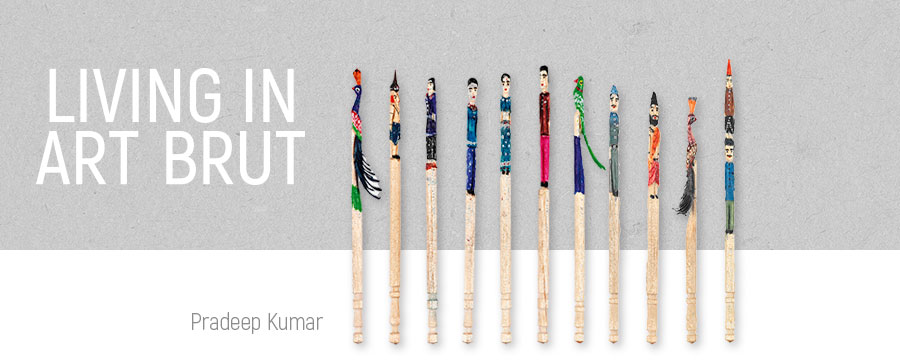First Encounters with Art Brut
My Art Brut story began in 1980. I went to an exhibition of Johann Hauser and Oswald Tschirtner, two of the best-known Gugging artists, in what was then the Museum of the 20th Century in Vienna. I was overwhelmed by Johann Hauser’s exquisitely colourful depictions of women, and by his boundless vividness. At the same time, I found myself fascinated by the startling contrast of Oswald Tschirtner’s small and unassuming black ink drawings. The most remarkable quality there was in his power of reduction. He is rightly regarded as a master of minimalist imagery. Because this exhibition was in a museum, it did not even occur to me that it would be possible to actually buy any of these works.
Four years later, in 1984, I visited another exhibition which really influenced me to focus on Art Brut. That was “Primitivism in 20th Century Art” at the Museum of Modern Art in New York, showing famous artists of the 20th century such as Pablo Picasso, Alberto Giacometti, and Henri Matisse together with their collections of African and Oceanic sculptures. The striking juxtaposition of their work with these tangible objects of inspiration made a huge impression on me. There was also a section dedicated to Dada and Surrealism. Many surrealists, such as Max Ernst and Joan Miro, were influenced by primitivism and by art from psychiatric institutions.
My First Purchases
These exhibitions in Vienna and New York inspired my interest in Art Brut. But it was another seven years before I purchased my first Gugging works by Johann Korec and August Walla from the Galerie Chobot in Vienna in 1991. I have been buying ever since. In the 1990s I became a customer of every gallery that had an exclusive Gugging focus, and since 1993 I have been a customer of Gugging itself. The first time I went there it was Johann Hauser who showed me the way to the House of Artists, when I asked for directions in the “Old Coffeehouse”. At the time I was in my mid-thirties, working as a manager in a specialist bank, and was in the process of building up my second career pillar as a consultant. From 2000 to 2006 I was a board member of the association Freunde des Hauses der Künstler in Gugging.
Because Gugging was basically only open to men, the women in Gugging are particularly important to me. I have an unusual friendship with Laila Bachtiar, the only woman who works at the studio and is represented by the gallery. I meet with her and her mother several times a year, even outside of Gugging. I am delighted that my collection includes works by Karoline Rosskopf and Barbara Demlczuk, two of the very few female artists from the Leo Navratil era.
It was my mother, a declared feminist, who always particularly insisted that there should be female artists in my collection. At some point I became aware that independent female collectors of Art Brut are rare. Rarer still are female collectors who collect work by female Art Brut artists to a significant extent. As a result, when my collection started to become more international about ten years ago, I introduced a focus on female artists
My Strategy
My strategy consists of three core themes: the first is my aim to round out the Gugging focus with early historical works or new artists. The second is my specific focus on female artists. The third is my concentration on international Art Brut. Following this strategy, I allow the art to come to me, rather than trying to chase it down: I receive offers from international galleries and collections, and make my decisions.
For me, collecting Art Brut is a professional project. Of course I am not just a collector, but also an economist, consultant for professional development, and lecturer. This involves a certain type of reflection. And the context of my collection is a very specific one.
“Field research” is very important to me in my approach to Art Brut as a field of contemporary art. It includes visits to museums and exhibitions, and related travel. I have also developed a diverse network of contacts including artists, gallerists, museum directors, curators, art historians, collectors, psychiatrists, writers, and representatives from art universities and copyright associations. All their different viewpoints and experiences provide me with a steady flow of new impulses, inspirations, ideas, and visions for the future of my collection. My Art Brut project helps me to find a sense of connection and orientation in a world that is in a constant state of flux.


